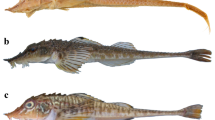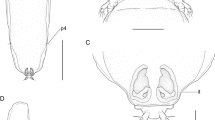Abstract
A redescription of the poorly known Lecithochirium grandiporum (Rudolphi, 1819) is given based on numerous specimens collected from the stomach of the moray eel Muraena helena in the waters off the Scandola Natural Reserve, Corsica, in the Western Mediterranean. This species, abundant in all specimens of the moray eel studied in this region, is shown to be a valid species and not stunted specimens of L. fusiforme Lühe, 1901, a common parasite of the conger eel Conger conger which has developed in the wrong host. Comparative morphological and metrical studies, based on numerous specimens from the same geographical area, show that L. grandiporum from M. helena and L. fusiforme from C. conger and Lophius piscatorius represent one and the same species, the latter becoming a junior synonym of L. grandiporum. In addition, a list of the digenean species collected from each of these three fish species from off the Scandola Natural Reserve is given, showing the similarities between their digenean fauna.




Similar content being viewed by others
Notes
Similar data have been reported by Looss (1907, pp. 601–602).
References
Bartoli, P., & Gibson, D. I. (2006). The occurrence of the Japanese species Dinosoma lophiomi Toman, 1973 (Digenea: Hemiuridae) in Lophius piscatorius (Teleostei) from the western Mediterranean. Systematic Parasitology, 65, 251–261.
Bartoli, P., Gibson, D. I., & Bray, R. A. (2005). Digenean species diversity in teleost fish from a nature reserve off Corsica, France (Western Mediterranean), and a comparison with other Mediterranean regions. Journal of Natural History, 39, 47–70.
Bray, R. A. (1991). Hemiuridae (Digenea) from marine fishes of the southern Indian Ocean: Genus Lecithochirium Lühe, 1901 (Lecithochiriinae). Systematic Parasitology, 16, 193–219.
Gibson, D. I. (2002). Superfamily Hemiuroidea Looss, 1899. In D. I. Gibson, A. Jones, & R. A. Bray (Eds.), Keys to the Trematoda (Vol. 1, pp. 299–304). Wallingford: CAB International.
Gibson, D. I., & Bray, R. A. (1979). The Hemiuroidea: terminology, systematics and evolution. Bulletin of the British Museum (Natural History), Zoology Series, 36, 35–146.
Gibson, D. I., & Bray, R. A. (1986). The Hemiuridae (Digenea) of fishes from the north-east Atlantic. Bulletin of the British Museum (Natural History), Zoology Series, 51, 1–125.
Juel, O. (1889). Beiträge zur Anatomie der Trematodengattung Apoblema (Dujard.). Bihang till Kongl. Svenska Vetenskaps-Akademiens Handlingar, 15(4,6), 1–46.
Linton, E. (1898). Notes on trematode parasites of fishes. Proceedings of the United States National Museum, 20 (1133), 507–548.
Linton, E. (1901). Parasites of fishes in the Woods Hole region. Bulletin of the United States Fisheries Commission, 20, 405–492.
Linton, E. (1905). Parasites of fishes of Beaufort, North Carolina. Bulletin of the Bureau of Fisheries, Washington, 24, 321–428.
Looss, A. (1899). Weitere Beiträge zur Kenntnis der Trematoden-Fauna Aegyptens zugleich Versuch einer natürlichen Gliederung des Genus Distomum Retzius. Zoologische Jahrbücher, Systematik, 12, 521–784.
Looss, A. (1907). Zur Kenntnis der Distomenfamilie Hemiuridae. Zoologischer Anzeiger, 31, 585–620.
Looss, A. (1908). Beiträge zur Systematik der Distomen. Zur Kenntnis der Distomenfamilie Hemiuridae. Zoologische Jahrbücher (Systematik), 26, 63–180.
Lühe, M. (1901). Über Hemiuriden (Ein Beitrag zur Systematik der digenetischen Trematoden). Zoologischer Anzeiger, 24, 473–488.
Manter, H. W. (1940). Digenetic trematodes of fishes from the Galapagos Islands and the neighboring Pacific. Allan Hancock Pacific Expeditions, 2(14), 325–497.
Mola, P. (1928). Vermi parassiti del’ittiofauna Italiana. Bolletino di Pesca, di Piscicoltura e di Idriobiologica, 4, 395–443
Molin, R. (1859). Nuovi myzelmintha raccolti ed esaminati. Sitzunsberichte Akademie Wissenschaften. Mathematisch-Naturwissenschaftlich Classe. Wien, 37, 818–854.
Nasir, P., & Diaz, M. T. (1971). A revision of genus Lecithochirium Luehe, 1901 and redescription of L. monticellii (Linton, 1898) Skrjabin and Guschanskaja, 1955. Rivista di Parassitologia, 32, 27–36.
Nicoll, W. (1915). A list of the trematode parasites of British marine fishes. Parasitology, 7, 339–278.
Olsson, P. (1868). Entozoa iakttagna hos Skandinaviska hafsfiskar. I. Platyelminthes. Acta Universitatis Lund, 4 (1867), 1–64.
Papoutsoglou, S. E. (1976). Metazoan parasites of fishes from the Saronicos Gulf Athens – Greece. Thalassographica, 1, 69–102.
Rudolphi, C. A. (1819). Entozoorum synopsis, cui accidunt mantissa duplex et indices locupletissimi. Berolini: Sumtibus Augusti Rücker, 811 pp. + 3 plates.
Sey, O. (1970). Parasitic helminths occurring in Adriatic fishes. Part II (Flukes and tapeworms). Acta Adriatica, 13(6), 3–15.
Vilas, R., Paniagua, E., Outeiral, S., & Sanmartín, M. L. (2002). Electrophoretic and morphological differentiation of three sympatric species of the genus Lecithochirium (Trematoda: Hemiuridae), parasites of marine fishes. Parasitology Research, 88, 1055–1060.
Vilas, R., Paniagua, E., & Sanmartin, M. L. (2003). Genetic variation within and among infrapopulations of the marine digenetic trematode Lecithochirium fusiforme. Parasitology, 126, 465–472.
Vilas, R., Criscione, C. D., Paniagua, E., & Blouin, M. S. (2006). Microsatellite loci from the trematode Lecithochirium fusiforme, a parasite of the European conger eel. Molecular Ecology Notes, 6, 1064–1066.
Acknowledgements
Fieldwork on Corsica was carried out under the auspices of the Comité Scientifique de la Réserve Naturelle de Scandola, and PB was funded by the French Ministère de l’Environnement and by the Régional Authorities of Corsica. Dr R. A. Bray kindly read a draft of the manuscript.
Author information
Authors and Affiliations
Corresponding author
Rights and permissions
About this article
Cite this article
Bartoli, P., Gibson, D.I. The status of Lecithochirium grandiporum (Rudolphi, 1819) (Digenea: Hemiuridae), a rarely reported and poorly known species from the Mediterranean moray eel Muraena helena L. in the Western Mediterranean. Syst Parasitol 68, 183–194 (2007). https://doi.org/10.1007/s11230-007-9095-5
Received:
Accepted:
Published:
Issue Date:
DOI: https://doi.org/10.1007/s11230-007-9095-5




